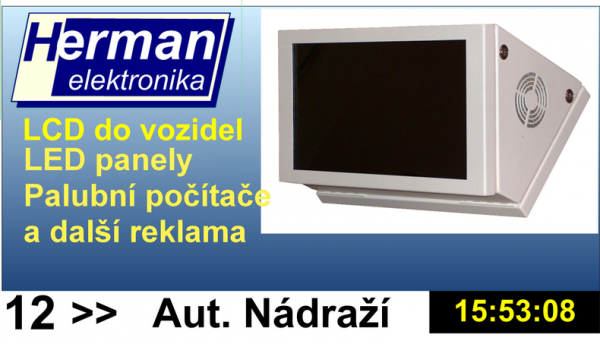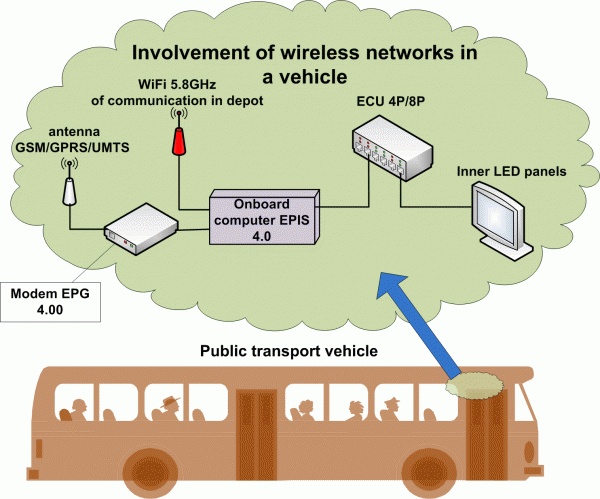Surveillance information system for commercials and news
Surveillance information system for commercials and news
Page content:
Basic description of the system layout
„The surveillance information system for advertisements and news“ is designed for remote management of commercials, news and traffic information in vehicle LCD panels for passengers (e.g. VCS 185A, VCS 185B, and others…) and not only there (it can be used generally). It is a complex system for remote management of and access to information displayed in vehicles of transportation companies (both municipal and regional). Commercials, news and traffic information broadcasted in vehicles are provided and monitored from one or more servers, e.g. a commercial company server can provide individual commercial spots and general news while a server of a transportation company or a regional organizer of public transportation can provide traffic information and news. The vehicle LCD – server communication uses GSM networks – see the following picture.

Picture 1: General layout of the surveillance information system for commercials, news and traffic information.
Basic properties of the RsWeb commercial and news server
The RsWeb application was developed by our company. This application updates commercial spots and videos, general news and traffic information and controls the state of vehicle LCDs, i.e. whether the LCD panels show the required spots or whether there is an error. The surveillance server gathers information about LCD monitors (time and place) and stores, processes and assesses it (e.g. whether an advertisement fulfilled its set number of repetitions over a given period of time). The application can be managed remotely via a web environment.
General news and commercials are set via a web environment. When setting the commercials, the commercial company also defines the number of repetitions of a spot over the period of one hour and therefore can guarantee a defined number of broadcasts to the client. Based on the knowledge of vehicle readiness the system itself assesses whether the set number of repetitions of a given commercial is realistic and also how much capacity is left in the system.
All operational setting data including types and validity, progress of displaying and cancelling of commercials is backed up on the server during the whole period of its validity. After the end of the period of validity the vehicle operational database and the records of server-vehicle communication are backed up for a set period of time.
Updating data in vehicle LCDs for passengers
The principle of the system of „remote commercial surveillance“ can be seen in the picture no.1 above. The picture also shows two ways of updating data in LCDs for passengers in public transportation vehicles:
- Direct – via a mobile operator data network run by the transportation company (APN), when an LCD in a vehicle regularly updates data for broadcasting while the vehicle is on its way (on-line updates). This concepts makes it possible to include up to date news or traffic information in a very short time.
- Indirect – through a transportation company center where data updates are performed with the help of wifi networks placed in depots (e.g. with the help of the RADON service). The broadcasted files are stored in a commercial data storage. The standard data update functions of the SW SPRINTER are used to perform updates of data in vehicles. This way is recommended for uploading vehicle LCD FW, basic templates for scripts etc. It is also suitable for complete LCD display data replacements.
Data updates of both systems – direct and indirect – are mutually independent. Data updates from commercial companies and transportation companies are also mutually independent. Both suppliers thus can set spot and picture broadcasts independently and the LCD itself distinguishes which is to be broadcasted based on set rules.
The basic way of passenger LCD behavior is created with the help of the „CityScreenInfo“ composer.
Vehicle installation
A vehicle of a transportation company can be installed in two ways depending on the type of the vehicle control system – EPIS 4.xx (for municipal public transportation) a EPIS 5.xx (for regional public transportation):
- Installation with the MHD EPIS 4.xx can be seen in the following picture where the on-board computer uses passenger LCD data updates in depots (the RADON service) and now it is also equipped with the ability to update data using the RsWeb server. A GPRS/UMTS modem –EPG 4.00 is connected to the on-board computer to ensure communication via a GSM/GPRS/UMTS mobile operator network.
- Installation with the EPIS 5.xx on-board computer with checking for regional public transportation that already contains a GPRS/UMTS modem and it can also communicate via wifi in depots which makes the installation much easier.
The on-board systems also supervise correct functioning of the system (solve communication with LCDs). If LCD displays are not working they announce it to the RsWeb server and to the transportation company to ensure servicing.
If a small modification is done the system can be installed in such a way that it broadcasts public wifi for passengers.
Broadcast time and place definition
Commercial, news and traffic information data is carried by a public transportation vehicle (both municipal public transportation and regional public transportation) and inside the vehicle, the data carrier is the LCD for passengers (the VCS types). The broadcasting itself is controlled autonomously on the vehicle level – playing of the content proceeds by preset rules and is clocked by a superordinate LCD if more LCDs are used in one vehicle (necessary when 2 or more LCDs are used). Decisions regarding the usage of rules is made by the vehicle (broadcasting is not synchronized within a network but within the vehicle).
The system is set in such a way that while a vehicle is at a stop, only traffic information is broadcasted, either about the line (see picture 4) or other traffic information (e.g. about detours, traffic changes, etc.).
After a vehicle leaves a stop, information about the next stop is shown, then commercials and general news can start. Information that is normally displayed on inner LED vehicle panels can be shown on the bottom line (see picture no. 5, where information about the date and time is displayed on the bottom line). Time ratios of broadcasting times can be modified with the help of parameters stored in the vehicle and set using the SW composer „CityScreenInfo“ .

Picture 5: Commercial broadcasting together with information about the direction of the vehicle and the current time.
Commercials, general news and traffic information are always terminated when the doors are opened regardless the state of their broadcasting and basic information about the direction and the line as set by the transportation company is shown.
Commercials and general news are shown when the vehicle is moving. The length of such broadcasts can be configured, i.e. traffic news, information about the line, commercials and general news alternate. When commercials are shown, two types of displaying can be used:
- Commercial spots with a display frequency with a time condition (it can also be based on the GPS position).
- News (on the basis of rules set by the user of this part of the system).
Traffic news from a transportation company or a regional IDS coordinator is shown during set periods of time and is not displayed to the seller of the commercial time. This means that there are two independent systems alternating in set time intervals.
Data format for displaying
CityScreenInfo – supports the following types of video formats that are also supported by our LCD HW (e.g. VCS 185, etc.):
- MPEG-2
- MPEG-4 ASP (DivX)
- H.263 (MPEG-4 short-video header variant)
- MPEG-4 AVI (H.264)
- Windows Media Video 9 (WMV3)
- Windows Media Video 9 Advanced (VC-1 Advanced profile)
Supported picture formats:
- jpg,
- bmp,
- jpeg,
- wbmp,
- png,
- gif.
 Site map
Site map


